e-Photon/ONe IST project
 Optical Networks: Towards Bandwidth Manageability and Cost Efficiency
Optical Networks: Towards Bandwidth Manageability and Cost Efficiency
February 2004 – February 2006
FP6-001933
The proposed Network of Excellence (NoE) aims at integrating and focusing the rich know-how available in Europe on optical communication and networks, both in universities and in research centres of major telecom manufacturers and operators. The set of available expertises ranges from optical technologies, to networking devices, to network architectures and protocols, to the new services fostered by photonic technologies.
NOBEL IST project
 Next Generation Optical Networks for Broadband European Leadership
Next Generation Optical Networks for Broadband European Leadership
January 2004 – February 2006
FP6-506760
The overall goal of the IST project NOBEL is to find and to validate (experimentally) innovative network solutions and technologies for intelligent and flexible optical networks, thereby enabling broadband services for all.
TRIPODE
TRIPODE
December 2002 – December 2005
FEDER-TIC-2003-04334-C02-02
Proyecto nacional sobre nuevas arquitecturas de redes opticas.
LION IST project
 Layers Interworking in Optical Networks
Layers Interworking in Optical Networks
January 2000 – March 2003
IST-1999-11342
LION aims at giving answers to Network Operators (N.O.) about interoperability of client transport networks (e.g. ATM, SDH, IP-based) over an optical server one recommended as Optical Transport Network (OTN). In particular, the major target is to design and test over a testbed a multi-layer resilient network in a multi-domain environment. First the N.O. requirements will be defined for envisaged multi-layer network scenarios. Cost-effective integrated resilience strategies will be investigated supported by planning evaluations. The ITU-T functional modelling will be adopted to define first the OA&M and management requirements and then specifications for interfaces between network clients and OTN and between OTN domains. An “umbrella” management architecture that enables integration of TMN, WBEM, and SNMP will be designed to allow N.O. to manage the network as a whole. The above requirements and specifications will be translated into systems and sub-systems implementation to test in a testbed.
DAVID IST project
 Data and voice integration over DWDM
Data and voice integration over DWDM
July 2000 – October 2003
IST-1999-11742
Main objective is to propose a Packet-over-WDM network solution, including traffic properties and management, based on optical packets and asynchronous transmission over metro and backbone distances. The project will capitalise on both optics and electronics to find out the optimum combination to reach multi-Tb/s capacity. To cope with the on-going convergence in the transport of voice, data and multimedia applications, the project will also define several classes of service, adapted to optical layer specifics. On the metro side, the project will consider a buffer-less network using a medium access control protocol. The backbone will be based on 10 Tb/s multi-layer (wavelength and packet) opto-electronic medium access control protocol with opto-electronic packet routers, incorporating core and edge functions. Finally, the project will demonstrate highly integrated optical and electronic devices, included in a sub-equipped experimental platform.
COST 266
Advanced Infrastrucutre for Photonic Networks
February 1999 – July 2003
The main objective of the action is to propose and evaluate suitable architectures and identify the key photonic components for the infrastructure of next generation photonic networks and work out alternative scenarios for the evolution towards next generation networks.
ECOPAQ
Evaluación de la conmutación óptica de paquetes
December 1999 – December 2002
TIC-99-0572-C02-02
Proyecto nacional sobre la evaluación de las prestaciones de redes basadas en la conmutación óptica de paquetes.
SONATA ACTS project
 Switchless Optical Network for Advanced Transport Architecture
Switchless Optical Network for Advanced Transport Architecture
April 1998 – December 1999
AC-351
The main objective of SONATA is to define and demonstrate a single-layer network platform for end-to-end optical connections between a large number of terminals for business and residential customers. Time and wavelength-agility at terminals will be heavily exploited simplifying the network structure to only a single node providing passive routing functions and, optionally, actively controlled wavelength conversion. By eliminating the need for complex nodes within the network, this non-traditional approach will offer an effective and viable solution for the realisation of high capacity all-optical networks, easily able to cope with the predicted traffic increase generated by the new future telecommunication services. The advantages of this “switchless” network will be fully investigated and evaluated at the technical, management and economic levels, by means of system studies and modelling, component development, laboratory experiments and implementation of network demonstrators.